
The F Street House is today a historic 19th-century mansion in Washington, DC, blocks away from the White House, that serves as the official residence of the President of the George Washington University. It is a registered landmark on the National Register of Historic Places and was previously known as the Steedman-Ray House, Alexander Ray House, and as the F Street Club.

The Farmers' and Exchange Bank is a historic commercial building in Charleston, South Carolina. Built in 1853–54, it is an architecturally distinctive building, with Moorish Revival features rarely seen in the United States. The building is recognizable for its use of muqarnas—characteristic of Persian and North African architecture—as well as its large arched windows and striking red sandstone facade. It was declared a National Historic Landmark in 1973.
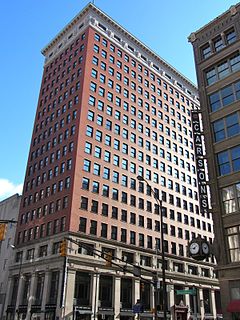
The Barnes and Thornburg Building is a high rise in Indianapolis, Indiana originally known as the Merchants National Bank Building. In 1905, the Merchants National Bank and Trust Company engaged the architectural firm of D. H. Burnham & Company of Chicago to design a new bank headquarters on the southeastern corner of the Washington and Meridian streets, the most important intersection in Indianapolis. Initial occupancy of the lower floors took place in 1908, while the upper floors were not completed until 1912.

Riggs National Bank is a historic former headquarters of Riggs Bank, located at 1503–1505 Pennsylvania Avenue, Northwest, Washington, D.C., in the downtown Washington, D.C. neighborhood.

The American Security and Trust Company Building is a Neoclassical bank office in Washington, D.C., designed by the architectural firm of York and Sawyer. It was listed on the National Register of Historic Places in 1973.

The Banco Crédito y Ahorro Ponceño building, a historic building in Ponce, Puerto Rico, was the first and main office of the historic Banco Crédito y Ahorro Ponceño, and represents one of the last examples of the once popular turn-of-the-century eclectic architecture. The building was listed on the U.S. National Register of Historic Places on June 25, 1987. It was built in 1924. The building was owned by Banco Crédito y Ahorro Ponceño which was one of the largest banking companies in the country of Puerto Rico during most of the twentieth century.

The First National Bank Building is an historic building located in downtown Davenport, Iowa, United States. It was individually listed on the National Register of Historic Places in 1983. In 2020 it was included as a contributing property in the Davenport Downtown Commercial Historic District. The building is now known as the US Bank Building, its main tenant.

The Customhouse and Post Office in Georgetown, Washington, D.C., was completed in 1858 in a Renaissance Revival–Italian Palace style. Construction cost was $55,468. The first floor was occupied by a branch post office and the second floor by the Customs Service. It was listed on the National Register of Historic Places in 1971. It was already included as a contributing building within the Georgetown Historic District.

The Bank of Xenia is a historic former bank building in downtown Xenia, Ohio, United States. Built in 1835, it was the location of Greene County's first bank, which opened on June 1 of that year. For thirty years, the building was used as a bank, becoming the local branch of the State Bank of Ohio in 1846 and changing its name to First National Bank in 1863. After First National moved to a newer building in 1865, it was no longer used as a bank; among its later owners was A.C. Messenger, a physician who used it as his home and office. In the 1880s, the bank was a party to a lawsuit known as Xenia Bank v. Stewart, which was decided by the United States Supreme Court in 1885.

The Athenaeum is a gallery of fine arts and a performance venue in Alexandria, Virginia, United States. It is also home to the Northern Virginia Fine Arts Association since 1964. The building is an important example of Greek Revival architecture. The Athenaeum has a long history and has served several purposes during its lifetime. The building is now part of the Virginia Trust and was listed on the National Register of Historic Places in 1980.

The Auto Freight Transport Building of Oregon and Washington, also known as East Side Terminal and Eastbank Commerce Center, in southeast Portland in the U.S. state of Oregon is a four-story commercial structure listed on the National Register of Historic Places. Built in 1924, it was added to the register in 2005.
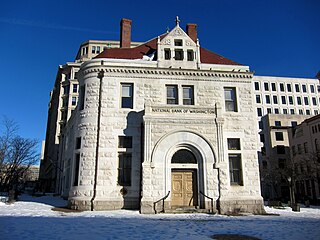
The Washington Branch of the National Bank of Washington is a historic bank building located in Northwest, Washington, D.C.
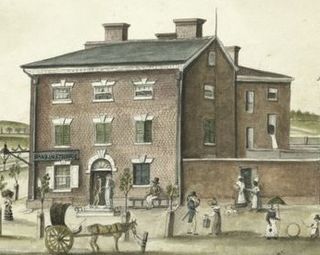
Rhodes Tavern is the site of a historic tavern in the early history of Washington, D.C. It was located at 15th Street and F Street, Northwest, Washington, D.C.
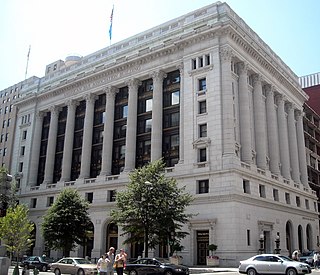
The Union Trust Building is a nine-story office building, located at 740 15th Street, Northwest, Washington, D.C. It was constructed for the Union Trust Company between 1906 and 1907. The building is listed on the National Register of Historic Places, and is a contributing property to the 15th Street Financial Historic District. It sits on the location of Wormley's Hotel, owned by James Wormley, a free-born black man, where the Wormley Agreement was penned, which led to the Compromise of 1877 and the election of President Rutherford B. Hayes. It has been substantially expanded twice, first in 1927 and then converted to a modern office building in 1983.
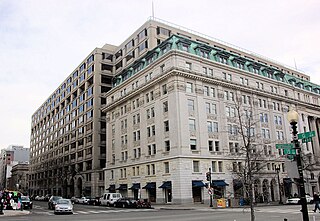
The Chase's Theater and Riggs Building, also known as the Keith-Albee Theater and the Keith-Albee Building, was a historic building located at 1426 G Street and 615-627 15th Street, Northwest, Washington, D.C., in the city's Downtown area.

The National Metropolitan Bank Building is an historic structure located at 655 15th Street, NW in Downtown Washington, D.C.

Commercial National Bank is an historic structure located in Downtown Washington, D.C. It was listed on the National Register of Historic Places in 1991.

Appleton Prentiss Clark Jr. was an American architect from Washington, D.C. During his 60-year career, Clark was responsible for designing hundreds of buildings in the Washington area, including homes, hotels, churches, apartments and commercial properties. He is considered one of the city's most prominent and influential architects from the late 19th and early 20th centuries. Many of his designs are now listed on the National Register of Historic Places (NRHP).

The Farmers and Mechanics Bank is a historic building in the Georgetown neighborhood of Washington, D.C. Constructed between 1921 and 1922, the bank was first the headquarters of the Farmers and Mechanics National Bank. Soon thereafter, it became known as the Farmers and Mechanics Branch of Riggs National Bank. In 2005, the building became a branch of PNC bank.




















